1. Outline allegation made. More detailed account awaited.
On 17 October 2022 Sharon O’Neill of the Sunday Life newspaper in Belfast reported that an alleged victim of child sex abuse had named Lord Louis Mountbatten as one of his tormentors. His name is Arthur Smyth and he was a temporary resident of Kincora in the 1970s.

Kincora was run by three men who were convicted of child abuse in December 1981: William McGrath, Joseph Mains and Raymond Semple.
McGrath has been named as the man who made Arthur Smyth available to Mountbatten. Smyth says he was abused twice in Kincora in 1977 by Mountbatten. McGrath exploited him for months afterwards. In later life, the trauma of what he had experienced drove him to attempt suicide by driving his motor cycle into oncoming traffic. He was badly injured and taken to hospital.
The outline provided so far lacks detail.

What was known before Arthur Smyth emerged is that McGrath and Mains were part of an Anglo-Irish paedophile ring. I have described it as the Anglo-Irish Vice Ring (A-IVR). Children in care were trafficked to VIPs including:
- Lord Louis Mountbatten, who had a holiday home in Co. Sligo in the Republic of Ireland;
- Peter Montgomery, the Deputy Lord Lieutenant of Tyrone;
- Sir Anthony Blunt, the Keeper of the Queen’s Pictures who was a frequent visitor to Peter Montgomery in Co. Tyrone;
- Lord Rosse of Birr Castle, Co. Offaly in the Republic of Ireland;
- Sir Samuel Knox Cunningham QC, MP, Private Secretary to Prime Minister of the UK, Harold Macmillan; and
- Alfred Arnold, Private Secretary to the Prime Minister of Northern Ireland, Sir Basil Brooke.
- Peter England, a friend of Alfred Arnold who served as a high ranking official at the Northern Ireland Office in the 1970s. He was convicted and fined £100 for a sex crime committed in a public toilet in London in the 1970s.
- John Imrie, a senior MI5 officer stationed at the NIO in the 1970s. In 1979 he was convicted for a sex crime committed in a toilet at Victoria train station in London.
2. Carl Beech caveat
A number of years ago a person or persons unknown gave approximately £100,000 in secret to a paedophile called Carl Beech. Prior to this, Beech was someone who had trouble managing to pay his rent.
Beech made claims he had been sexually abused by VIPs. But he was lying.
Beech used the money to purchase a property in Sweden for himself, and planned to acquire another for his mother. He opened bank accounts under an assumed name. He may also have acquired travel documents – even a false passport – under one or more of his false identities. He went by the following names: Stephen Anderson aka Carl Anderson aka Samuel Karlsson.

There are strong grounds to suspect that Beech was part of a sophisticated plot by surviving members of the A-IVR to convince the public that no VIP abuse had taken place. The allegations Beech made were copied from those of genuine victims. He then added a series of dramatic lies about extreme sadism and murder, all of which were untrue. In due course, the lies were exposed. The intention all along, it appears, was that Beech would be exposed as a liar.

The British public became convinced that the notion of VIP abuse of children was a fantasy as a result of Beech’s lies. Not a single British journalist entertained the suspicion the British public was being taken for fools. For further details see: Does ‘Nick’s’ conviction mean Jimmy Savile and Ted Heath are innocent? Yes, if you work for the British tabloid press. By Joseph de Búrca
Beech was about to disappear to begin his new life when he was arrested and charged with the deliberate telling of lies to the police.
3. The boy abused by Mountbatten who appears in a photograph taken in London. He was meant to have been in Belfast at the time.
The man who most likely oversaw the Beech deception is a former MP with a penchant for sadistic sex. ‘Sean’, a Kincora boy was trafficked to London where the MP abused him. As part of the abuse ritual, the MP took ‘Sean’ to a restaurant. ‘Sean’ kept a card from the restaurant, the Napoleon Club, now closed. There are also photos of ‘Sean’ in London at this time.

‘Sean’, is also one of the boys abused by Mountbatten in Ireland. (See the sections below about ‘Sean’ and ‘Amal’.)

The British media invariably ignores evidence of wrondoing at Kincora, including the links between Mountbatten and Kincora. On this occasion, however, English newspapers, including the right wing, pro-Establishment Daily Telegraph, have reported the allegations made by Arthur Smyth. This is most unusual. They are the same papers that once highlighted Beech’s claims. It is as if a conscious and co-ordinated decision has been taken at the highest levels of the pro-Establishment media to shine a light on Smyth.
If this analysis is correct, why has this u-turn taken place?
Who is being manipulated?
If Arthur Smyth is a plant sponsored by others – such as the sadistic ex-MP – a question arises as to why he and his associates feel it necessary to go to such lengths to undermine the existing evidence that Mountbatten was part of a paedophile network that preyed upon boys in Ireland.
4. Stephen Waring, the Kincora boy and victim of Mountbatten who committed suicide.
Joseph Mains, who worked with McGrath at Kincora, trafficked at least three other boys to Mountbatten in Co. Sligo in the Republic of Ireland. Mountbatten took his annual holiday there each August. Mountbatten owned Classiebawn, a mock Baronial castle in Sligo. One of the victims was Stephen Waring. He and another boy, ‘Sean’, were abused by Mountbatten in August of 1977.

The November after his experience at Classiebawn, Waring escaped from Kincora. The RUC were alarmed especially as he and ‘Sean’ were threatening to expose the abuse which they had suffered. He managed to reach Liverpool, but was captured by the police and put back on the Belfast-Liverpool Monarch Ferry. Waring was placed in a part of the ship which did not have access to outdoor parts of the ship. Somehow, he broke out of it and climbed over the vessel’s railings and plunged to his death. A witness – a British solider – was reputed to have said that he was very drunk at the time of his fall. It is difficult to understand how he became drunk, hours into a late night ferry crossing. The Liverpool police hardly let him onboard with a bottle of spirits. His body was never recovered. No autopsy has ever taken place. See also: https://villagemagazine.ie/a-kincora-boy-abused-by-mountbatten-committed-suicide-a-few-months-late/
5. ‘Sean’.
‘Sean’, the boy who accompanied Waring to Classiebawn, has spoken to me on numerous occasions. He also spoke to my friend Andrew Lownie, author of a biography of Mountbatten (published in 2019)

The abuse suffered by Waring and ‘Sean’ took place in a building adjacent to Classiebawn Castle.
‘Sean’ and Stephen Waring knew they were being taken to the Republic of Ireland because Mains, who was sitting in the front of the vehicle, turned around and told them that they had crossed the Border.
As Andrew Lownie described it in his biography of Mountbatten, ‘Sean’, was 16 years old when he says he was driven from the Kincora Boys Home in Belfast to Classiebawn in the summer of 1977. As the men who had brought them waited outside, ‘Sean’ remembers being taken into a darkened room where he was joined by ‘a man who undressed me and then gave me oral sex. I was there about an hour. He spoke quietly and tried to make me feel comfortable. He was one of those men who wanted attention, wanted you to chase him . . . I think he felt some shame. He said very sadly, “I hate these feelings”. He seemed a sad and lonely person. I think the darkened room was all about denial . . . He grabbed my hand and put it on his chest . . . I only recognised who he was when I saw on the news that Lord Mountbatten had been killed.
‘Sean’ told me that he recalled noticing a ‘weird castle’ in the distance as they neared their final destination. This is in fact a very good description of what the building looks like as it is approached. He also recalls that Mountbatten had a butler with a toupée who attended upon them before Mountbatten took Waring away first. He also vividly described his memory of seeing an oar hung on the wall of the room in which he was kept.
6. ‘Amal’, the Sri Lankan boy living in England who was trafficked to Mountbatten in Ireland.

‘Amal’ is the fourth person who has accused Mountbatten of child sex abuse committed in Ireland. He was 16 when he was trafficked from London to Mountbatten in Co. Sligo. He told Andrew Lownie how he remembered “being brought to Mullaghmore during the summer of 1977”. He says he met Mountbatten four times that summer on day trips from Belfast. Each time the encounter, lasting an hour, took place in a suite at a hotel by the harbour about 15 minutes from Classiebawn. ‘Amal’ remembered that Mountbatten was:
very polite, very nice. I knew he was someone important. He asked if I wanted a drink or candy. He told me he liked dark-skinned people, especially Sri Lankan people as they were very friendly and very good-looking. I remember he admired my smooth skin. We gave each other oral sex in a 69 position. He was very tender and I felt comfortable about it. It seemed very natural. I know that several other boys from Kincora were brought to him on other occasions.
7. The FBI’s files on Mountbatten’s ‘lust for young boys’ .
Lownie’s research also unearthed a number of FBI files which revealed that the Royal had been gripped by “a lust for young boys”, and that his former chauffeur, Ron Perks, often drove him to “an upmarket gay brothel used by senior naval officers” called the Red House near Rabat in Malta while he was serving in the Royal Navy.

The FBI began compiling its Mountbatten dossier in February 1944, shortly after Mountbatten became Supreme Allied Commander of Southeast Asia.
The FBI interviewed Elizabeth de la Poer Beresford, Baroness Decies. According to the FBI file: “She states that in these circles Lord Louis Mountbatten and his wife are considered persons of extremely low morals”. Also that he “was known to be a homosexual with a perversion for young boys”. Her opinion of him was that he was “an unfit man to direct any sort of military operations because of this condition”. She stated further that “his wife Lady Mountbatten was considered equally erratic”.
The Americans maintained their observation of Mountbatten after WW2, especially after he became NATO commander of allied forces in the Mediterranean, then Admiral of the fleet, and later Chief of the defence staff.

8. Norman Nield, Mountbatten’s personal driver who was aware he was abusing boys aged 8-12.
Norman Nield, a naval rating, was Mountbatten’s personal driver between 1942-43. At the time Mountbatten was living in a large house at Fareham, Hampshire, near Portsmouth. According to Nield, Mountbatten was a “boy lover” and a “sexual deviant” who preyed on young boys to fulfil his bizarre sexual fantasies. An interview Nield gave to an Australian newspaper in 1987 can be read in full here: Mountbatten, the Royal who abused boys aged 8-12.
Mountbatten used brandy and lemonade to help seduce his young victims, Nield claims. “On several occasions I had to take it to him in his room at the house when he was with a boy,” he said. The boys were aged from about 8 to 12. “On one occasion I walked in on him and he had a semi-naked boy sitting on his knees. It didn’t really shock me at this stage but L.L. [Lord Louis] was taken by surprise. He ordered me from the room and there was a fuss but next day things were back to normal”.

Nield revealed that the “boys [were] always very quiet and withdrawn [and] never appeared distressed afterwards.
“L.L. often paid me additional lump sums of money. Sometimes it was 40 pounds and on one occasion I received 100 pounds as hush money”.
9. Mountbatten in Sri Lanka.
Mountbatten spent some of WW2 in Sri Lanka. An Irish doctor lived at Mountbatten’s lodge years later. The locals told him of the many boys brought to the residence during Mountbatten’s occupancy of the lodge.

10. Mountbatten and the United World College
In 1967 Mountbatten became the first president of the United World College (UWC). It emerged from discussions which took place at NATO’s Defence College in Paris during the Cold War.
The UWC opened its first school in Wales in 1962 with the aim of bringing “young people from different backgrounds” together.

After he took over in 1967, Mountbatten expanded it into an international movement. He oversaw the foundation of national committees which selected students and promoted the UWC in other countries. UWC schools soon appeared in Singapore (1971) and Canada (1974). Prince Charles (as he was then) became president in 1978.
It is likely Mountbatten was attracted by the opportunities to meet young male UWC students through his involvement in the movement.
11. Alfred Arnold, the Prime Minister of Northern Ireland’s aide, the paedophile who set up the Anglo-Irish Vice Ring (A-IVR) of which Mountbatten was the highest-born member.

The architect of the A-IVR was Alfred Arnold. He served as Private Secretary to Sir Basil Brooke, PM of NI, 1943-63. While child abuse among the aristocracy has been going on for centuries, it was Arnold who turned the abuse into a system which transformed care homes run by the Stormont Government into places from which children could be taken and raped. Paedophiles (adults who sexually abuse children) and pederasts (adult males who sexually abuse adolescent boys) were assigned to run them and supply children to the A-IVR. See also: a Not just Ted Heath: British Establishment paedophilia and its links to Ireland
Arnold could be quite indiscreet: it was he who boasted to Robin Bryans, the author and Kincora whistleblower, that boys from a home in Portadown were being abused.

12. Lord Rosse of Birr Castle, a friend of Mountbatten and an abuser of boys.
Yet another friend of Mountbatten was Lord Rosse, the denizen of Birr Castle in Co. Offaly in the Republic of Ireland. Rosse became Princess Margaret’s step-father-in-law after she married Anthony Armstrong-Jones (later Lord Snowdon).

In a series of letters Bryans put into circulation in the 1980s (the then equivalent of tweeting), he provided a glimpse of the debauchery in Northern Ireland. In one letter dated 3 November 1989, he described the type of events that took place when Mountbatten and Rosse got together with the likes of Sir Anthony Blunt and a man called Alan Price. The relevant sentence reads as follows: “Any of the old snapshots at Birr Castle showing the late Lord Rosse getting Alan Price to flash his prize codpiece for Lord Mountbatten and Anthony Blunt are unlikely to be published”.

Joseph Mains trafficked boys from Kincora to Birr Castle. They included Richard Kerr who had first been raped in the middle of the night as he clung to a toy in his bed at Williamson House.
The abuse at Birr Castle came to the attention of Colin Wallace and the military intelligence department at Lisburn in the 1970s. See also: SECOND UPDATE: The Irish government has become complicit in the cover-up of British Royal sexual abuse committed in the Republic of Ireland. By Joseph de Burca.

13. Mountbatten’s Irish child pimps.
The existing evidence is that three men trafficked boys to Mountbatten in Ireland: Mains, Peter Murphy and Peter Montgomery.
Murphy procured boys for Mountbatten from Portora Royal College, Enniskillen.
Robin Bryans, wrote about Murphy’s closeness to Mountbatten in his book ‘The Dust Has Never Settled’. He made no bones about the fact Murphy was a lustful paedophile, stating that he and an Irishman called Alan Price “looked for more than Portora schoolboys to lure to their beds”.
In one of his public letters, distributed in the 1980s, Bryans revealed that Alan Price was part of Mountbatten’s circle in Ireland; as was Sir Anthony Blunt, the Keeper of the Queen’s Pictures (and a member of the infamous Cambridge Ring of traitors. (See section 16 which concerns Blunt.)
14. Mountbatten and the Deputy Lord Lieutenant of Tyrone, Captain Peter Montgomery.
Another of Mountbatten’s friends was Captain Peter Montgomery, a cousin of ‘Monty’, the famous WW2 field marshal. The captain lived at a magnificent estate in Blessingborne, County Tyrone. Montgomery later became Deputy Lord Lieutenant of Tyrone, which meant he was one of an elite number of personal representatives of the Queen in Ulster. He also became President of the Northern Ireland Arts Council.
Montgomery let William McGrath, the ‘housefather’ of Kincora, use Blessingborne to train members of Tara, the Loyalist paramilitary organisation he – McGrath – commanded.
According to Bryans, who knew Montgomery well, the latter procured boys from Portora Royal College, Enniskillen, for those in the vice ring with a penchant for well-bred children.

Peter Montgomery also had access to boys at Williamson House in Belfast. Eric Witchell, another member of the vice ring, was in charge of Williamson House. Witchell is alive and living in London. The Independent Inquiry into Child Sexual Abuse failed to interview Witchell.
The boys from Williamson House were brutalised and transformed into sexual playthings for the vice ring. Anal rape commenced at the home when the boys – orphans and abandoned underprivileged children – were as young as six. A number of these victims later committed suicide.
15. Mountbatten and Sir James (Jimmy) Savile.
The TV presenter Sir James (Jimmy) Savile is the most infamous of all British paedophiles. He was a child rapist, a man who had sex with corpses.
Savile was a friend of Mountbatten. He once boasted: “Whenever it came to doing anything, he [Mountbatten] would say, ‘I’ll cut the ribbon but get Savile down. He can do the speeches. He does it better than me’.”

Saville claimed that he got to know Mountbatten through their involvement with the Royal Marines. Savile told his biographer Dan Davies about his first alleged meeting with Mountbatten. “He was commandant general [of the Royal Marines]. It was the attraction of opposites. He had not the faintest idea of who I was or what I did. All I knew was that I was a freak with long hair. He wanted to know what this long-haired geezer was doing with this crack fighting corps.”
Savile claims his handling of the press during inquiries about the purchase of expensive chandliers by the Royal Marines, so impressed Mountbatten, that he decided he was an asset who should be embraced by the Royal Family. This is difficult, if not impossible to believe. It is far more likely their mutual paedophilia was the connecting glue.

Mountbatten proceeded to introduce Savile to King Charles (the then Prince of Wales). “It was the respect that Lord Louis had for me. It meant what was good enough for Lord Louis was good enough for [Charles].”
Savile advised King Charles during his messy and turbulent marriage to Lady Diana Spencer.
When the Variety Club threw a special dinner to honour Savile in June 1978, at the Dorchester Hotel, Mountbatten sat next to him.
Savile enjoyed unfettered access to Buckingham Palace.

The British police knew that Savile was a child molester. One of the reasons he was not arrested was because of his friendship with Mountbatten and others in the ‘Firm’, as he dubbed the Royal Family.
16. The Keeper of the Queen’s Pictures, another paedophile and friend of Mountbatten
Mountbatten and Montgomery were also friendly with Sir Anthony Blunt, the Keeper of the Queen’s Pictures, and a cousin of the late Queen Mother. Blunt enjoyed the ‘rough trade’ – the abuse of impoverished male urchins condemned to eke out a living as male prostitutes in seedy toilets in London. Blunt ‘cottaged’ for them around the lavatories in Hyde Park near to Speakers’ Corner, despite his left-wing pretence of concern for the underprivileged.

Blunt worked for MI5 during WW2 and then pursued a career as an art historian. He became a knight of the realm and Surveyor of the King’s (and later Queen’s) Pictures. His world was turned upside down in November 1979 after he was exposed as a Soviet mole by Robin Bryans and others.
Blunt got to know Montgomery at Cambridge. Montgomery became one of Blunt’s earliest lovers, possibly even his first. Montgomery always kept a room for Blunt at Blessingborne, and Montgomery often stayed with Blunt when he visited London. When Blunt suffered nervous exhaustion in 1943, it was to Ulster and the embrace of Montgomery he repaired for recuperation.
The journalist Paul Foot, who spoke at length to Bryans, gained an insight into how Blunt became:
closely involved with the Orange establishment in Northern Ireland, and particularly with the hyperactive and reckless set of gay people who flourished in the Six Counties [of Northern Ireland] throughout the period … Especially attractive to this set was the apparently limitless supply of boys of all shapes and sizes. This supply was quite unrivalled anywhere else in the United Kingdom and became legendary in upper-class homosexual circles. It was regarded as a “special treat” to go to Northern Ireland and get yourself invited to one of the “soirées” which would be well attended by not entirely literate or well-adjusted teenage boys. No one ever asked where these boys came from, but some at least were provided through the extremist Orange gang which ran boys homes for Belfast Corporation, notably the one called by an old Irish Royal folk name, Kincora. (Private Eye No. 681, 22 January 1988)
Blunt’s treachery was uncovered by MI5 in 1963 (but not revealed to the public until 1979). In 1964 he agreed to make a confession in return for immunity and the wholesale betrayal of the secrets of everyone he knew. Peter Wright of MI5 was assigned to interrogate him. In return for his co-operation, Blunt was given a pardon and his treachery was concealed from the public. The pardon was not limited to his treason: in addition it afforded him blanket immunity for any crime he had ever committed, something undoubtedly designed to cover his sexual transgressions with children.

When Peter Wright sat down with Blunt in 1964 he was determined to smoke out any member of the intelligence community, military, civil service or Parliament who – like Blunt – was homosexual: in short anyone of importance who might have been susceptible to blackmail by the Soviets. Homosexuality remained a crime in England and Wales until 1967.
Blunt’s face-to-face encounters with Wright would drag on for seven years. They were still proceeding apace during the early years of the Troubles by which time MI5 and MI6 were keen to find any mechanism to gain control and influence over Loyalist politicians and paramilitaries in Northern Ireland. Blunt and the details he had disclosed provided much for them to exploit.
17. MI5, the FBI and Mountbatten
Wright’s odyssey into the hidden recesses of Blunt’s life unravelled an array of friends and associates in Ireland. Wright undoubtedly came across the name of Mountbatten on many occasions.

Wright’s close friends in the FBI harboured suspicions that Mountbatten was a traitor and concerned that he had access to NATO naval secrets. Hence, they kept the files on him which author Andrew Lownie uncovered.
Incredible as it may seem, the FBI was also interested in Peter Murphy, Mountbatten’s close friend, as they believed he was a Marxist.
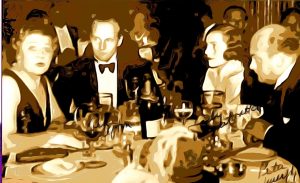
18. Sir Samuel Knox Cunningham MP, QC, Private Secretary to the Prime Minister.
While at Cambridge, Blunt made more Irish friends. One of then was Sir Samuel Knox Cunningham who was slightly younger than him. Cunningham became known as the ‘Boxing Queen’ because of his homosexuality and prowess as a pugilist. He was a heavyweight boxing champion at Cambridge. In later life he was elected as a Unionist MP. In the 1960s he represented South Antrim. He served as Parliamentary Private Secretary to Prime Minister Harold MacMillan, 1959-1963, and as such routinely attended Cabinet meetings at 10 Downing Street.

Knox Cunningham often stayed with Blunt while in London and also knew Guy Burgess from their days at Cambridge. (Burgess was once in MI5. He was another traitor. He defected to the USSR with Donald McClean.)
Cunningham was a rich man and lived on a 70-acre estate at Glencairn Park. He once came within an inch of becoming Grandmaster of the Orange Order. He chose not to stand in the 1970 general election and was succeeded by his fellow Orangeman and election agent, James Molyneaux, who later led the Unionist Party, 1979-95.

Robin Bryans also knew Cunningham well. Cunningham was a key participant in the A-IVR. Bryans recalled that Cunningham “always liked to appear as the great Queen’s Counsel who knew more than anybody about everybody, especially those in my books and bed”.
Cunningham was one of those who financed William McGrath’s paramilitary organisation, Tara.
A memorandum Captain Colin Wallace prepared while working at the British Army’s HQNI at Lisburn, stated that Cunningham was “closely associated” with William McGrath, the Housefather at Kincora, and was “aware of his activities”.

Cunningham became involved in the World Alliance of Young Men’s Christian Association (YMCA) in 1947 and became Chairman of its National Council two years later, something which put him in charge of the YMCA in Ireland, Wales and England. His Wikipedia entry suggests that he became involved with the YMCA because of his “religious faith” but it is more likely he wanted to gain access to young men. Much of his interaction with the YMCA boys involved the sport of boxing. According to Bryans, he took Kincora boys to the YMCA in England.
Cunningham, a barrister, acted for John McKeague after he was charged with molesting two YMCA boys in 1966 at Bushmills, Co. Antrim.
Richard Kerr, a survivor of Kincora, has revealed that Knox Cunningham was a visitor to Kincora.

At the start of Blunt’s debriefing, Peter Wright’s interest in Cunningham would have centred on the fact he had sat around the Cabinet table, was gay and a friend not only of a self-confessed KGB mole (Blunt) but also another traitor who had defected to Moscow, Guy Burgess. By the end of the debriefing in the early 1970s, Cunningham’s lofty position within the Orange Order and central role in Unionist politics would have been of equal interest to MI5. Cunningham was one of many homosexuals active inside the Orange Order who were susceptible to blackmail, especially as homosexuality was still a crime in Northern Ireland.
19. Kincora, layer upon layer of interwoven criminality and wrongdoing.
The Kincora scandal involves layer upon layer of interwoven criminality and wrongdoing:
- Children were sexually abused by the A-IVR, some as young as six years of age;
- Some of the abusers were blackmailed by MI5 and MI6, a crime in its own right;
- MI5 and MI6 collected kompromat about Loyalist politicians such as James Molyneaux, the Leader of the Unionist Party. A senior figure in the DUP was recorded with a boy in a bedroom at the Park Avenue hotel in Belfast.

- Loyalist serial killers such as John McKeague were recruited to murder MI5-RUC targets;
- These murders were covered up on both sides of the border. A future Garda commissioner, Larry Wren, failed to investigate the murder of Seamus Ludlow in the Republic of Ireland properly in a full and proper manner. Ludlow was shot by McKeague’s Red Hand Commando;
- The course of justice was perverted by the RUC, MI5, MI6, the NIO, Whitehall and the Wren faction of the Gardai;
- Deliberate fraud was committed by Sir George Terry, author of the 1982 Terry Report about Kincora. Terry was chief constable of the Sussex Police.

- Victims of the abuse were vilified – and continue to be vilified – as liars and fantasists by elements of the British media. The British media suppressed evidence in its possession about the scandal. One of the most high-profile political broadcasters on British TV withdrew a story from a newspaper he edited. It featured an interview with a British Army general which exposed elements of the scandal;
- Some victims were driven to suicide, others to a life in prostitution;
- As a sick perk of their job, certain NIO and MI5 officials including Peter England and John Imrie abused children in the grip of the network.
- Alan Campbell, the chief suspect in the abduction, murder and dismemberment of Brian McDermott (aged 10) was protected by MI5 and the RUC. (See section 19 below.)

20. MI6 has admitted a ‘relationship’ between Joe Mains and Sir Maurice Oldfield of MI6.
In 1980 MI5 (which is attached to the British Home Office) carried out an inquiry into the conduct of the former Chief of MI6, Sir Maurice Oldfield, 1973-78. MI6 is attached to the Foreign Office. This happened because Oldfield had been caught lying about his homosexuality. Oldfield was also an abuser of ‘rent boys’, underage male prostitutes. MI6 reviewed their files relating to the matter in 2011. According to the Hart Report, “Officer G” of MI6 “examined four ring binders with material relating to Sir Maurice Oldfield, including the 1980 MI5 investigation”.

Officer G proceeded to describe a “relationship” Oldfield had “had with Kincora boys’ home (KBH) in Belfast”. Oldfield was linked to Kincora “through his friendship with the KBH Head”.
21. MI5 admitted to Hart that it had ‘compromising’ film of a member of the Kincora gang – John McKeague – a serial killer and paedophile.

One of the key figures in the paedophile gang which revolved around Kincora was John McKeague. MI5 admitted at the Hart Inquiry that it had compromising film of him and considered recruiting him as an agent, but, in the end, decided against it. They were undoubtedly lying. McKeague became one of their agents.
22. The child killer who benefited from the Mountbatten cover-up.
If Arthur Smyth is another Carl Beech, his task may be to neutralise fresh revelations that threaten to shine a spotlight on Alan Campbell, a member of the gang which abused the boys at Kincora and elsewhere. The information about Campbell relates to the murder of Brian McDermott. It has been suppressed by the BBC since May 2021. (See section 27.)
Alan Campbell was a friend of John McKeague, the sadistic and murderous leader of the Red Hand Commando. Both men were key figures in the Shankill Defence Association (SDA). Both were associates of Ian Paisley who set up the DUP. McKeague once served as Paisley’s bodyguard.
LIke Mains, McGrath and McKeague, Alan Campbell was undoubtedly an MI5 agent.

Campbell was the chief suspect in the kidnapped and murder of Brian McDermott in 1973. Part of his headless corpse was discovered – partly charred – in a bag in the River Lagan. Four other boys disappeared never to be found:
Jonathan Aven (14) 21 Sydenham Drive (20 Sept 1969);
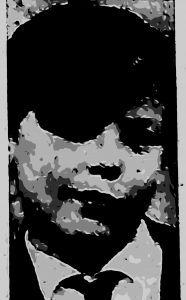
David Leckey (12) 24 Memel Street, Newtownards Road (25 September 1969);
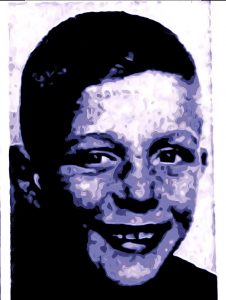
Thomas Spence (11) Rockdale Street, Belfast (26 November 1974);

John Rogers (13) Rodney Street, Belfast. (26 November 1974).

The RUC officers who investigated the McDermott murder were about to arrest Campbell for it. They informed British military intelligence at Lisburn of their intention. The Army was interested in Campbell because he was in Tara, the Loyalist paramilitary group commended by McGrath. Suddenly, the RUC was ordered to leave Campbell alone. Only MI5 and the NIO have that sort of power.
The evidence against Campbell was sufficiently substantial to form the basis for a criminal prosecution.
Years later the evidence was put aside while the RUC extracted a false confession from a relative of McDermott. Unless the attempt to frame the innocent man was designed to deflect attention away from Campbell, it is impossible to understand the behaviour of the RUC in this instance. Campbell died in 2017, aged 67.
It is not clear if the Campbell dossier was destroyed or not. Certainly, some legal documents relating to Campbell disappeared, allegedly during a bomb explosion.

23. Ken Larmour, Mountbatten and other “homes” in Belfast.
Ken Larmour, a paedophile, was a close friend of Alan Campbell. They were so close that Larmour lent Campbell his flat at Ross House, Shore Road, Belfast, to abuse boys. Campbell abused a 13 year old boy from Bawnmore, a care home, at the flat. Other members of vice ring abused boys at the flat.
Campbell threatened to knife his victims if they spoke out.
Larmour was also a member of McGrath’s Tara paramilitary organisation.
Although suspected as a paedophile by the RUC as early as 1971, he retained his job as a clerk at Belfast’s magistrate’s Court. He abused that position to assist members of the vice ring.
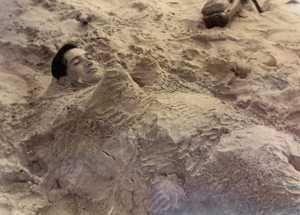
After Mountbatten was murdered by the IRA, Larmour spoke to JM, a boy he was abusing. JM has told me that: “Ken Larmour told me about Mountbatten’s death. He became tearful emotional, and said that he was very good to the kids at the homes in Belfast. Ken did not [usually] show emotion.”
Clearly, Mountbatten was not “very good to the kids at the homes”. Yet, the comment reveals that Mountbatten was given access to other care institutions and that this was common knowledge among the paedophile network in Northern Ireland.
JM recorded Larmour as an adult on tape confessing some of his crimes. The tape was furnished to the RUC. Ultimately, it was decided not to prosecute Larmour. One of the reasons stated was that the State could not afford to pay for a ticket for JM to fly to Belfast from the US.
24. MI5 and Mountbatten

Mountbatten’s rape of children in Britain, Malta, Sri Lanka, India and Ireland was concealed by MI5 and MI6 for a variety of reasons: deference to their perceived superiors and betters at Buckingham Palace; contempt for working class children, a grasping ambition for knighthoods; but above else, the protection of their joint interest in exploiting Kincora and the A-IVR. In addition, Mountbatten knew some of their dark secrets for he was involved in treacherous plots against the British government in league with rogue – but highly placed – MI5 and MI6 officers.
A rolling maul of MI5 and MI6 officers were deeply involved in a slew of plots designed to topple British PM Harold Wilson of the Labour Party. Wilson served two stretches as PM of the UK, the first in the 1960s and then in the 1970s. Some of those involved in the plotting against him included right-wing former military figures who tried to build private armies to counter the perceived threat from trade unions and the Soviet Union. One manifestation of the plotting was designed to overthrow Wilson and replace him with Mountbatten using the private armies and sympathisers in the military and the intelligence services. A version of the plot was depicted in an episode of the Crown with Charles Dance playing Mountbatten. (Season 3, Episode 5, ‘The Coup’.)

The first official history of MI5, ‘The Defence of the Realm’ (2009), implied that an unofficial plot against Wilson took place and that MI5 had kept a file on him. Lord Hunt, a former cabinet secretary concluded in a secret inquiry in 1996 that “there is absolutely no doubt at all that a few, a very few, malcontents in MI5 … a lot of them like Peter Wright who were right-wing, malicious and had serious personal grudges – gave vent to these and spread damaging malicious stories about that Labour government”.

Peter Wright of MI5 – the man who had interviewed Blunt about the A-IVR, was at the centre of some of these plots. He wrote about them in his multi-million bestseller, ‘Spycatcher’.
25. McGrath’s threat to Buckingham Palace.
The importance of Chris Moore, a truly remarkable investigative journalist, to the search for the truth about Kincora, cannot be exaggerated. He is the author of a book on the subject and broke significant ground while reporting for BBC NI. He developed multiple sources who were able to provide him with confirmation McGrath was an MI5 agent. After McGrath was released from prison – having served two years – the tenacious Moore tracked him down and confronted him. McGrath made one statement of enormous significance: he told Moore that, ‘This whole matter does not stop at Lisburn’. [Chris Moore, ‘The Kincora Scandal’, at page 210.]
What was McGrath hinting at?
Lisburn was the HQ of the British Army in Northern Ireland. It was also where MI5 and MI6 were based. Hence, McGrath was impliedly confirming MI5 and MI6 complicity in the affair. MI5 and MI6 are representatives of the British government (Home Office and Foreign Office). Additionally, the government is, of course, represented at Lisburn by the Army (Ministry of Defence).
Recall, McGrath said that the scandal did ‘not stop at Lisburn’. Thus, there were others who were implicated aside from the British government and its military and civilian security and intelligence services.
What power centre was not represented at Lisburn?
The Royal Family fits the bill. Obviously, the Windsors did not station any of their staff at Lisburn.
If Arthur Smyth’s allegations are true, it means that McGrath had first hand intimate knowledge that Mountbatten was a child molester.
If Smyth is not to be relied upon, it is still the case that McGrath was part of the gang which trafficked boys to the Royal at Classiebawn. McGrath could have known about the trafficking of ‘Amal’ and others to Classiebawn by Mains, and therefore that Buckingham Palace had a vested interest in covering-up the scandal.
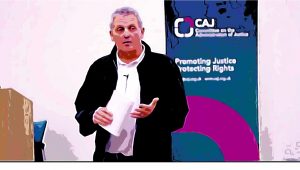
McGrath received at least £10,000 after his release. Was he issuing a subtle threat that he wanted the British Establishment to continue to look after him, or else? He was only convicted for a fraction of his crimes.
Was a violent, sadistic child rapist – a man responsible for driving neglected and disadvantaged human beings to commit suicide – a man who associated with serial killers such as McKeague and Campbell – dictating terms to the Royal Family?
26. The Independent Inquiry Into Child Sexual Abuse (IICSA).

The IICSA was established to inquire into VIP child sex abuse.
The IICSA ignored a mountain of evidence about Mountbatten and other VIPs.

It failed to address its core task – VIP sex abuse – in anything even remotely approaching a professional or competent manner.
The IICSA delivered the last of its reports on 20 October 2022. It contained recommendations “to better protect children” from predators. Sadly, the real message from this seven year, £186,600,000 probe, is that if you are a VIP abuser, or one of their underlings, no one will bother to investigate you.
The IICSA’s recommendations to better protect children could have been drawn up in an afternoon.
27. Other recent developments in a scandal that will not go away. The suppressed BBC NI documentary (since 2021) and report of Police Ombudsman (2022).
The Kincora scandal is not going away. It is the cancer festering inside the heart of the British Establishment.

A documentary about the activities of Alan Campbell was made for BBC NI by Alleycats. It was meant to have been broadcast in May of 2021. I was in touch with the researchers for Alleycats at the very early stages of the production. I fear the documentary will now never be broadcast despite years of diligent research. New ground was broken by the investigation. RUC officers who investigated Alan Campbell gave interviews on camera.
Too many people, however, know about the new information for it to remain under wraps forever.
In a separate development, in September 2022 the Police Ombudsman of Northern Ireland published a report which confirmed that the RUC knew about the abuse at Kincora yet failed to halt it.
In addition, Richard Kerr’s legal action against the NI state has yet to be heard. It has been repeatedly delayed but should proceed in Belfast in a few months.

28. The paedophile community knew about Mountbatten.
One of McGrath’s adult lovers, ‘C’, once a senior figure in the DUP, has admitted that he was an MI5 agent. ‘C’ was also a member of Tara.
Hence, we can list the following MI5/6 agents who were paedophiles in NI at this time: ‘C’, McGrath, Mains, McKeague and Campbell. There are strong indications that Ken Larmour belongs to the list too.
Mains had first hand knowledge that Mountbatten was a paedophile. Larmour knew Mountbatten was involved in ‘homes’ (i.e, more than Kincora).
Peter Murphy and Peter Montgomery knew too
Lord Rosse, Blunt et al obviously knew.

Overall, the wider NI paedophile network must have felt safe with Mountbatten among their number.
The gossip about Montgomery spread from the A-IVR to others such as Robin Bryans who was horrified at the plight of the victims and tried in vain to halt it. He approached a series of powerful figures including the wife of a former Tory prime minister who did nothing.
Despite all the knowledge, gossip and complaints, the State let the abuse – in reality torture – of small, frightened children proceed for decades.

29. MI5 have damaged the Crown to save their own hide.
MI5 and MI6 ran the Kincora exploitation operation. It is inconceivable that they did not know about Mountbatten’s connection to the vice ring. Yet, there is no indication that they warned Mountbatten to break his links with the gang. The Royal was still in contact with them in 1977, i.e., nearly four years after the murder of Brian McDermott.
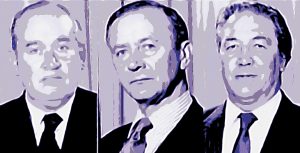
Ian Cameron and Denis Payne of MI5, along with Maurice Oldfield of MI6, were the officials who could have issued the warning.
Ultimately, the complicity of MI5 and MI6 in the cover-up since 1980 has achieved the very opposite of their intended aim. Their deceit has now, finally, brought the Royal Family into international disrepute.
30. The way out for the Palace: tell the truth, express regret, take the blow and move on.

Other child abuse victims of Mountbatten are watching what is happening.
The Prince Andrew-Epstein-Maxwell scandal involving the abuse of Virginia Roberts (Giuffre) offers the Palace a strategy to extricate the new king from the fallout of the Kincora scandal. King Charles has cast Prince Andrew aside. Andrew has been turned into a social leper. He will never visit the US again lest he be arrested. There will be no more glamorous trips abroad as a trade envoy. His former staff are describing how awful it was to work for him. He has been forced to pay millions in damages. The combined effect of all of this has been to hush those who were earlier baying for his blood. Andrew now cuts a lonely figure, traipsing around Windsor on a horse in between binging on TV box sets. Put simply, the Palace has survived the Prince Andrew scandal by implicitly acknowledging his guilt. (Before this, the Palace had gone to great lengths to preserve Andrew’s reputation. [For further details see: Judge a (future) king by his courtiers: Prince William and the Duchess of Cambridge, pawns in the cover-up of a transatlantic paedophile network.]

The Royal Archives at Buckingham Palace undoubtedly record some of the truth about Mountbatten, not to mention the insider knowledge possessed by the Royal Family. Hence, the Palace could silence the calls for the truth about Mountbatten by sharing at least something of what they know. They could concede that he was a child molester and then batten down the hatches for a storm that would blow itself out in a matter of weeks.
The Royal Family would undoubtedly survive.
The guilty parties responsible for the cover-up of the activities of the A-IVR and the murder of little Brian McDermott include the Cabinet Office, NIO, RUC, MI6 and MI5. I doubt very, very much anyone at Buckingham Palace knew about Alan Campbell and the murder of Brian McDermott until more recent times.
Why should King Charles allow MI5/6 tarnish his crown by dragging the Palace into the turpitude of the Campbell cover-up?
31. The Carl Beech #2 scenario.
There is another scenario, one of Machiavellian deceit and complexity which might yet unfold: Arthur Smyth’s legal action might fail on purpose – as part of a plan long in gestation – with the inevitable result that an outraged British public might then dismiss all allegations made against Mountbatten by whomsoever.
A similar outcome will ensue if Arthur Smyth turns out to be simply mistaken, or a fantasist acting on his own volition.
32. MI5, MI6 and the RUC/PSNI Special Branch, the ultimate traitors to the Crown.
Prince Charles (as he was) developed a concern for the environment decades before it became fashionable. He spent decades preparing to promote these types of issues as king. Now, as matters stand, his reign is being dogged by reports about Royal paedophilia such as the two page article from the Irish Mail (22 October 2022).

If the PR courtiers at the Palace remain true to form, they will take refuge in robotic denials that will make matters worse. Why are they acting thus, at least at present?
The answer is simple: MI5 and MI6 won’t let the truth emerge.
The reality of modern Britain is that the king has little or no real power and does as he is bid.
33. What next for King Charles?
If MI5 and MI6 were to give King Charles a free hand, there is a lot he could do to put his palace in order. In addition to a disclosure of what the Royals know about Mountbatten, King Charles could demand in public that the British government finally permit an honest inquiry to take place into the entire affair, led by competent people.

Do the families of the missing boys – the King’s own subjects – not deserve to know why the Royal Ulster Constabulary was prevented from arresting Alan Campbell for the murder of Brian McDermott?
Should the public learn what the PSNI, MI5, MI6 and NIO know about the disappearance of the other boys?:
- Jonathan Aven (14);
- David Lecky (12);
- Thomas Spence (11);
- John Rogers (13) .

Is the new monarch going to ask his new prime minister at one of their weekly meetings to unearth and disclose the full truth or bury his head in the sand?
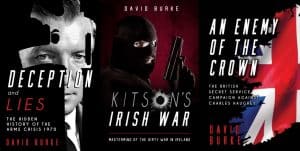
David Burke is the author of:
‘Deception & Lies, the Hidden History of the Arms Crisis 1970’, and;
‘Kitson’s Irish War, Mastermind of the Dirty War in Ireland’ which examines the role of counter-insurgency dirty tricks in Northern Ireland in the early 1970s, and;
‘An Enemy of the Crown, the British Secret Service Campaign against Charles Haughey’, which was published on 30 September 2022.
These books can be purchased here:
https://www.mercierpress.ie/irish-books/kitson-s-irish-war/
https://www.mercierpress.ie/irish-books/an-enemy-of-the-crown/
https://www.mercierpress.ie/irish-books/deception-and-lies
The Mountbatten Dossier and Operation Clockwork Orange are available on this website.


